(As told to Steve Reynolds by David Muirhead)
During a snorkel at Lady Bay on 27th October 2010, David Muirhead took this photograph of a Zebra Fish, Girella zebra with a ‘most unusual colour pattern’:
Zebra Fish with a ‘most unusual colour pattern’
(Taken by David Muirhead)
Here is a cropped image of the fish: –
Cropped image of the Zebra Fish with a ‘most unusual colour pattern’
(Taken by David Muirhead)
David contacted a few of Australia’s professional marine ichthyologists to question the matter, “without any definitive conclusion as to aetiology of this zebra fish’s most peculiar colour pattern”. They could not get past just tending to agree that it was quite unlikely a fungal cause.
“Mark McGrouther (at the Australian Museum) indicated he’d never seen the like of it, but he was at a loss to offer possible alternative causes,” said David.
“What with my being, like most frequent divers, familiar with occasional sightings of irregular blackish fungal blotches on various other individuals of mostly reef-associated fish species (e.g. some leatherjackets) such a hemi-symmetrical fungal growth seems to me either improbable or a rare freak,” he said, adding “So I speculated with Mark, and others, as to whether this might be a Darwinian adaptation, given the heavy grey/black silt loads entering the very bay for the past century or more, exactly where I see these weird ‘zebbies’, and I’ve never seen them until recent years despite having snorkelled and dived the site for nearly 50 years. And, the ‘black sheep’ always appear 100% fit and well, swimming as one in the schools with their ‘normal’ colleagues.”
“(It) could still be fungal, but I’m not at all happy with that explanation, and here are some more reasons why I’m not: –
- Any apparent blotchiness, and varying darkness of the fish’s right gill plate head and throat can, if one looks very closely, be fully accounted for by the better illuminated main subject ‘zebbie’, hence the normal bands are darker too, and hence the subtle surface tissue humps/lumps/throat grooves, nostrils et al will be expected to reflect a different shade of grey, but these areas have exact equivalent surface irregularities (=normal anatomy) on left hemi-cranium, but are much more difficult to see due that side’s contrasting paleness.
- If fungal, even viral or bacterial, why have I seen some ‘zebbies’ like this and others with both sides of head black, L=R exactly, and yet others with (mostly or always symmetrical) black caudal parts i.e. caudal fins and caudal peduncles +/-anal fins, but normal heads.
And if somehow we imagine a herpetiform viral cause, the colour distributions are never dermatomal i.e. quite unlike shingles in humans for example. (It) doesn’t add up.”
David later sent me a couple more photos of Zebra Fish with a ‘most unusual colour pattern’, taken 2 weeks earlier in the same area (Lady Bay):
Black-headed variant of Zebra Fish (partly obscured)
(Taken by David Muirhead at Lady Bay, SA 11-10-2010)
Black-headed variant of Zebra Fish (among ‘normals’)
(Taken by David Muirhead at Lady Bay, SA 11-10-2010)

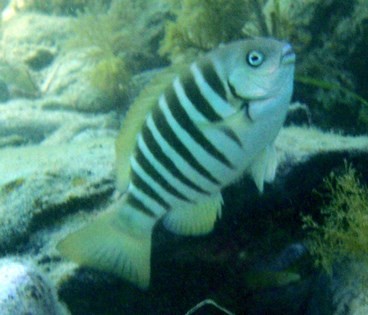
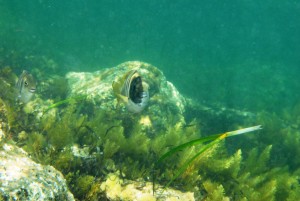
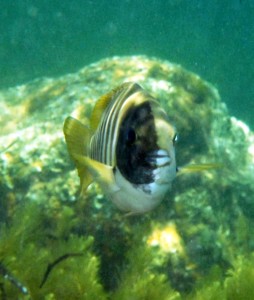
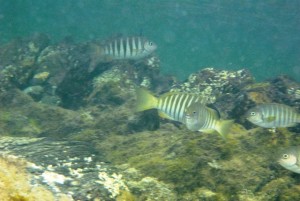
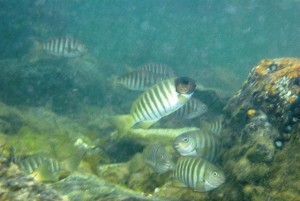
[…] described a most peculiar colour pattern in zebra fish, Girella zebra in A Most Peculiar Colour Pattern in Zebra Fish (as told to Steve Reynolds by David […]
[…] David Muirhead had reported cases of zebra fish with black heads before (A Most Peculiar Colour Pattern in Zebra Fish, Girella zebra ), I asked him what he made of the black-headed silver drummer in Renate’s […]